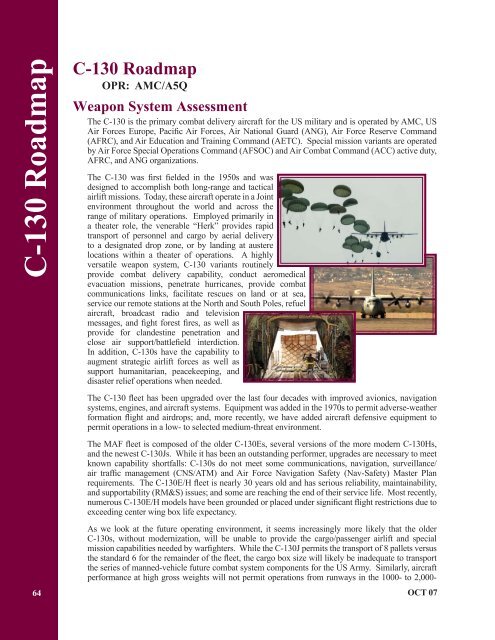Air Mobility Plan, 2008 - The Black Vault
Air Mobility Plan, 2008 - The Black Vault
Air Mobility Plan, 2008 - The Black Vault
You also want an ePaper? Increase the reach of your titles
YUMPU automatically turns print PDFs into web optimized ePapers that Google loves.
C-130 Roadmap<br />
64<br />
C-130 Roadmap<br />
OPR: AMC/A5Q<br />
Weapon System Assessment<br />
<strong>The</strong> C-130 is the primary combat delivery aircraft for the US military and is operated by AMC, US<br />
<strong>Air</strong> Forces Europe, Pacific <strong>Air</strong> Forces, <strong>Air</strong> National Guard (ANG), <strong>Air</strong> Force Reserve Command<br />
(AFRC), and <strong>Air</strong> Education and Training Command (AETC). Special mission variants are operated<br />
by <strong>Air</strong> Force Special Operations Command (AFSOC) and <strong>Air</strong> Combat Command (ACC) active duty,<br />
AFRC, and ANG organizations.<br />
<strong>The</strong> C-130 was first fielded in the 1950s and was<br />
designed to accomplish both long-range and tactical<br />
airlift missions. Today, these aircraft operate in a Joint<br />
environment throughout the world and across the<br />
range of military operations. Employed primarily in<br />
a theater role, the venerable “Herk” provides rapid<br />
transport of personnel and cargo by aerial delivery<br />
to a designated drop zone, or by landing at austere<br />
locations within a theater of operations. A highly<br />
versatile weapon system, C-130 variants routinely<br />
provide combat delivery capability, conduct aeromedical<br />
evacuation missions, penetrate hurricanes, provide combat<br />
communications links, facilitate rescues on land or at sea,<br />
service our remote stations at the North and South Poles, refuel<br />
aircraft, broadcast radio and television<br />
messages, and fight forest fires, as well as<br />
provide for clandestine penetration and<br />
close air support/battlefield interdiction.<br />
In addition, C-130s have the capability to<br />
augment strategic airlift forces as well as<br />
support humanitarian, peacekeeping, and<br />
disaster relief operations when needed.<br />
<strong>The</strong> C-130 fleet has been upgraded over the last four decades with improved avionics, navigation<br />
systems, engines, and aircraft systems. Equipment was added in the 1970s to permit adverse-weather<br />
formation flight and airdrops; and, more recently, we have added aircraft defensive equipment to<br />
permit operations in a low- to selected medium-threat environment.<br />
<strong>The</strong> MAF fleet is composed of the older C-130Es, several versions of the more modern C-130Hs,<br />
and the newest C-130Js. While it has been an outstanding performer, upgrades are necessary to meet<br />
known capability shortfalls: C-130s do not meet some communications, navigation, surveillance/<br />
air traffic management (CNS/ATM) and <strong>Air</strong> Force Navigation Safety (Nav-Safety) Master <strong>Plan</strong><br />
requirements. <strong>The</strong> C-130E/H fleet is nearly 30 years old and has serious reliability, maintainability,<br />
and supportability (RM&S) issues; and some are reaching the end of their service life. Most recently,<br />
numerous C-130E/H models have been grounded or placed under significant flight restrictions due to<br />
exceeding center wing box life expectancy.<br />
As we look at the future operating environment, it seems increasingly more likely that the older<br />
C-130s, without modernization, will be unable to provide the cargo/passenger airlift and special<br />
mission capabilities needed by warfighters. While the C-130J permits the transport of 8 pallets versus<br />
the standard 6 for the remainder of the fleet, the cargo box size will likely be inadequate to transport<br />
the series of manned-vehicle future combat system components for the US Army. Similarly, aircraft<br />
performance at high gross weights will not permit operations from runways in the 1000- to 2,000-<br />
OCT 07
















